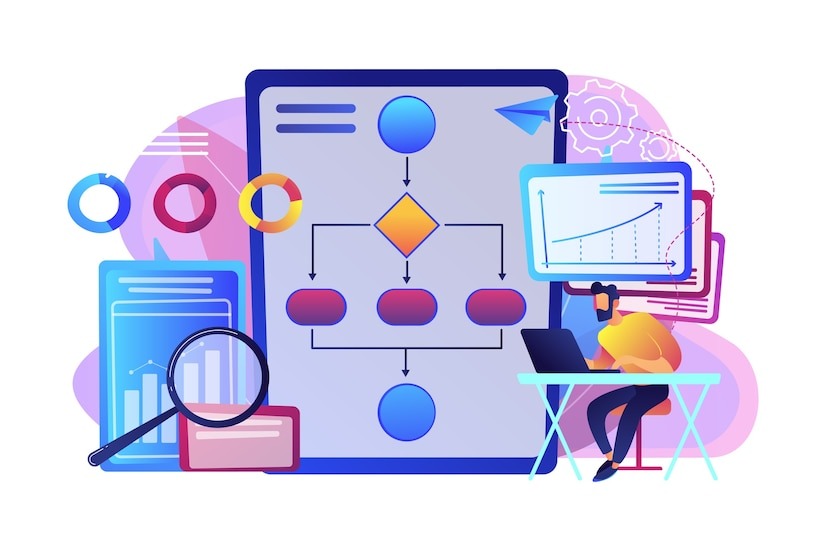In today’s corporate world, productivity and efficiency are critical. Workflow Management Systems (WMS) are becoming indispensable tools for firms looking to optimize their operations. These tools support the automation, simplification, and monitoring of a range of company operations, guaranteeing that work is done on schedule and neatly.
The possibilities of workflow management systems are expanding quickly as we go toward 2024, embracing cutting-edge technologies to satisfy the changing demands of contemporary businesses. To help organizations choose the best workflow management system for their requirements, this article will examine the 10 key features of a system for 2024.

-
A graphical user interface for swift scaling and simple solution implementation
Implementing a challenging product that requires deep coding or development knowledge would only worsen employees’ already challenging workflow management experience.
Choose a low-code automation platform or other intuitive workflow management solution to swiftly create large, scalable, automated workflows without developing a single line of code. These systems require little to no coding skills.
-
Conditional logic and automation capabilities
Employees may focus on more urgent initiatives by automating repetitive or routine procedures, including work handoffs, emails, approvals, and status updates. Timelines become more accurate with standardized and automated processes, reducing the need for double work in the future. Moreover, administrators can set pre-defined rules for various probable problems using if-this-then-that conditional logic. When a workflow encounters a problem, the program will automatically know how to resolve it. For instance, in the process of paying vendors, the software might detect that a bill does not have a purchase order (PO) and notify the vendor by sending a pre-written email with instructions on where to locate the PO and submit a corrected version of the bill.
-
Simple software integration for stack extensibility
Integrations facilitate connections if automation facilitates communication. Software that is simple to integrate with your current software facilitates establishing smooth connections that reduce rework and give workflow visibility.
Seek real-time integration with your current calendar, CRM, ERP, and document management systems. Transferring data between systems may only require one or two steps in specific processes, but those steps must be completed effectively and swiftly to maintain workflow flow. Integrating with your workflow management system should be simple and not require ongoing upkeep. Find out more about the extensibility of stacks.
-
Security features authorized by IT
Also, watch for improved cloud security, compliance, and user/guest permissions that support workflow security to safeguard your data—and maybe that of your clients. Permission levels and access control help prevent data breaches and protect private financial, payroll, and HR information.
-
Integrated audit trails for visibility into workflow
A significant issue impacting workflows is a need for more visibility and transparency. Look for a system with integrated audit trails for a full-access perspective of your workflows. This will help you better understand what’s working and what isn’t and how to rearrange the resources you already have to build more efficient processes.
-
Notifications on mobile devices
Features for mobile access and remote collaboration are becoming increasingly crucial as remote work and mobile technology grow in popularity. A contemporary WMS should include mobile applications that let users access workflows, approve tasks, and work with teammates at any time and from any location. These features guarantee that processes proceed even when staff members work remotely or on the fly, improving total productivity and responsiveness.
-
Status Indicators
Utilizing status indicators is an excellent method for keeping track of everything. A status dashboard allows users to identify problems, prioritize their work, and follow up on items they might have forgotten about. Each workflow’s participants should be able to view the statuses on a dashboard easily. Color coding is used in many automated workflows to differentiate between critical and non-critical concerns.

-
Due dates and notifications
Automated deadline warnings help keep workflows efficient and on schedule. Creating alerts and initiating automated actions depending on three status categories—overdue, late, and expired—enhances time management.
-
Dashboards and reporting based on KPIs
Strong workflow management tools will highlight bottlenecks, frequent failure sites, and tasks lasting longer than usual. Customizing dashboards to your own KPIs may help you identify processes that are missing or unnecessary. In addition to high-level data, they can include specifics like when tasks are finished, who completed them, and any helpful adjustments made to expedite a process.
-
Different methods for workflow visualization
Choosing a system that presents your processes in various ways will help you approach workflow management from a different angle, regardless of whether you prefer a list or calendar view. ‘Workflow visualization’ refers to the graphical representation of a workflow, which can help users understand the flow of tasks and identify areas for improvement.
In summary
The features of workflow management systems are growing as 2024 approaches, propelled by changes in corporate requirements and technological breakthroughs.
Implementing these crucial characteristics can improve productivity, promote continuous improvement, and streamline processes. Purchasing a contemporary workflow management system is not only a wise strategic move but also a must for businesses hoping to prosper in the cutthroat market. Upgraded workflow management systems can help businesses attain higher levels of productivity, agility, and success in the future.
